One manufacture chronograph is understated; the other is unconventional. Both are elegant. But which is better? We compare the Jaeger-LeCoultre Master Chronograph and the Montblanc Nicolas Rieussec Chronograph Automatic in this test feature from the WatchTime archives.
What’s your type? Is it classic or modern? Eye-catching or understated? Jaeger-LeCoultre’s Master Chronograph, from the brand’s manufacture in Le Sentier, Switzerland, is classically elegant and understated.
It debuted in 2010. Every detail is handsome and nothing is flashy or controversial. Its design embodies the serene sense of order found in traditional watch construction, which makes it a perfect companion to wear at the office as well as for gala occasions. Its price ($10,000*) isn’t extremely high, and when you wear it, you won’t look like you’ve lost touch with reality.
The second watch in our test, Montblanc’s Nicolas Rieussec Chronograph Automatic, is elegant as well, and it has a similar price ($10,700*). But it’s hard to further categorize this watch. Its materials and colors are subdued, but the unusual design of its dial draws attention. It debuted in 2011 as a further development of Montblanc’s first manufacture caliber, the MB R100, which was launched in the 2008 Nicolas Rieussec Monopusher Chronograph. Although Montblanc is based in Hamburg, Germany, its watches are made at the brand’s own ateliers in Le Locle, Switzerland.
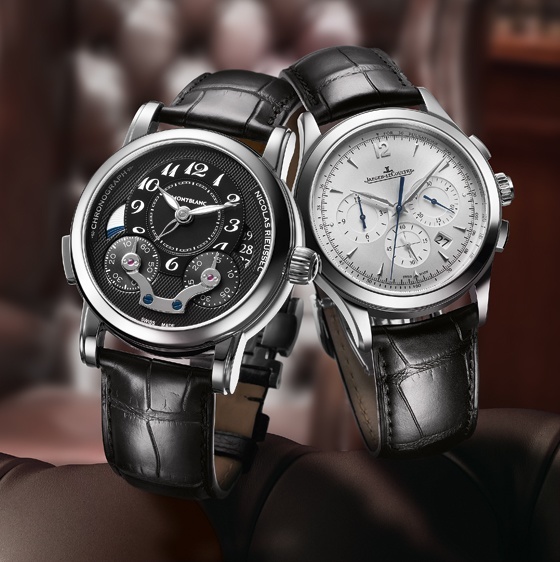
Is Montblanc’s chronograph classic or modern? This question is hard to answer. The off-center dial, with chronograph disks rotating under ashared bridge, looks very contemporary. But, in fact, this unusual arrangement for the stopwatch mechanism recalls a historical predecessor.
In 1821, Nicolas Mathieu Rieussec, who was watchmaker to the royal court of France’s King Louis XVIII, invented a “chronograph” in the truest sense of the word because his revolutionary device was indeed a “time writer.” (Chronos means “time” and graphein means “to write.”) Rieussec designed a tabletop apparatus with a wooden case that contained a pair of buttons and two rotating dials: one for the seconds, the other for the minutes. Above these dials he fastened a slender hand with ink-filled nibs attached to its tip. Rieussec unveiled his timing device at a horse race on the famous Champ de Mars in Paris. While the dials of the device turned, the timekeeper pressed a button the instant a horse crossed the finish line, causing the hands to touch the dials and leave little ink marks on them. For the first time ever, a timekeeper could capture the running times of all horses in the race without taking his eyes off the action. The times could later be read from the disks. Afterward, he simply wiped the ink off the disks and was ready to time the next race.
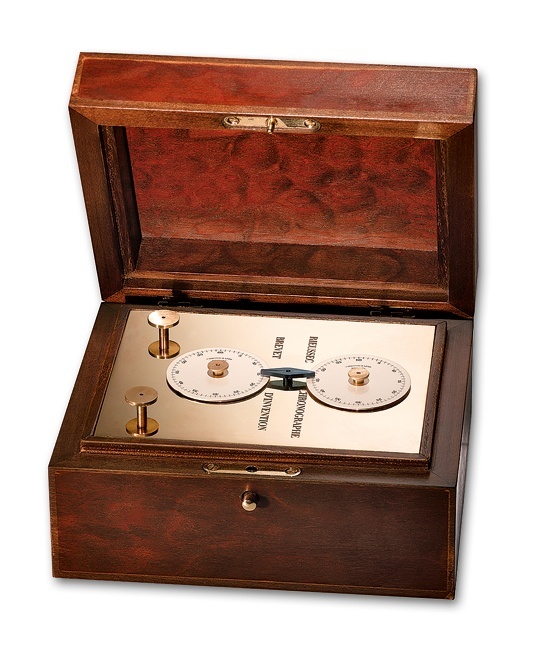
Montblanc’s Rieussec watch has similar rotating disks and a shared bridge across the dial. Both are distinctive features of the Nicolas Rieussec watch collection. But rather than depositing ink, the bridge of the watch holds rotating counters and stationary hands to show the elapsed seconds and minutes.
Although the design of Montblanc’s dial is historically inspired, it looks innovative. The model we tested is the most streamlined and elegant of the currently available Rieussec watches. Our editors were more impressed by it than by the other versions, whose openwork dials make them look technical rather than elegant.
How did our test watches rate when we considered their craftsmanship? We found both watches to be on very nearly the same high level. Their straps and clasps are simple but well crafted: Jaeger-LeCoultre uses a double-folding clasp without buttons; Montblanc relies on an unusually sturdy, single-folding clasp with safety buttons. The result is that Jaeger-LeCoultre’s watch is more comfortable to wear, but Montblanc’s clasp operates more easily. Each clasp is a good match for its watch: Jaeger-LeCoultre’s clasp is smaller and flatter while Montblanc’s is bulkier and more rounded.
Both dials and cases are immaculately crafted, but Montblanc’s have more facets and unusual details. However, we would have liked Montblanc’s case to have greater water resistance: it can withstand only 30 meters, while Jaeger-LeCoultre’s case remains watertight to 50 meters.
Depending on the feature we were examining, we found significant differences in user-friendliness between the two chronographs. Jaeger-LeCoultre builds its classic two-button chronographs with small seconds, a stop-seconds function and a rapid-reset date display. Montblanc’s watch has a date display, as well as an additional hand to indicate the time in a second time zone and a corresponding day-night disk at 9 o’clock. These extras give Montblanc’s chronograph a large number of functions, but the watch lacks a continually running seconds hand and a stop-seconds function. And since it’s a monopusher chronograph, when it’s used to measure brief intervals, it doesn’t allow additive timing; instead, the start, stop and return-to-zero functions must follow one another in sequence.
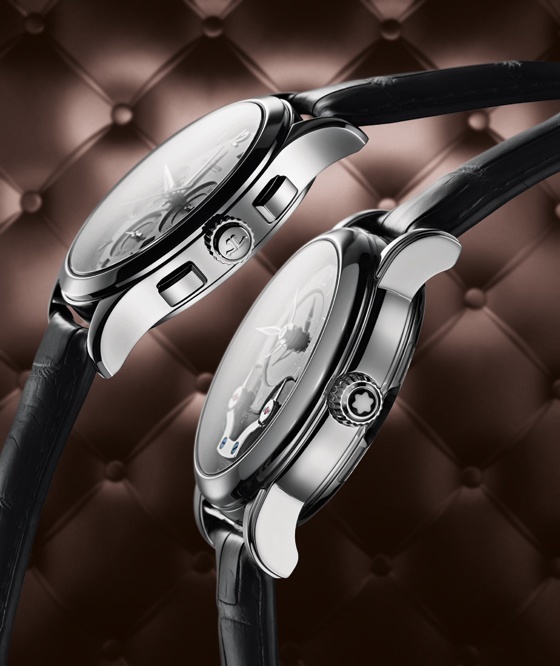
As with many other dual-time-zone watches, the Montblanc’s date can be reset fairly quickly by pulling the crown out halfway and then turning it clockwise or counterclockwise, which causes the hour hand to move forward or back in hourly increments. The counterclockwise operation allows the date to be reset more quickly in some instances than it could if you advanced a conventional rapid-reset date mechanism. When the time zone is reset, the second hour hand, which is skeletonized, remains motionless and continues to show the correct time in your home time zone. This hand disappears behind the main hour hand after you’ve returned home. Pulling the crown out to its second position lets you adjust the time.
We found too little contrast between the dial and hands on Jaeger-LeCoultre’s watch to easily read the time. And it’s hard to read the exact time quickly and to instantly tell the length of an elapsed interval with to-the-second precision because there is a pulse-measuring scale, rather than minutes numerals, around the edge of the dial. However, the subdials provide adequate contrast and are well marked.
We had some difficulty operating the Jaeger-LeCoultre watch. The small crown is hard to pull out, even if you slip your fingernail between it and the case. Furthermore, the newly reset minutes hand jumped either forward or back when we pressed the crown in, which necessitated repeating the setting process – an almost unpardonable flaw in a luxury watch. But we liked the stop-seconds function and the shaped pushers, which have good pressure points.
Montblanc’s crown is also a bit hard to pull out because your fingertips tend to slide off of it. The size of the chrono push-piece, on the left side of the case, adds user-friendliness, but it takes so little effort to trigger its “stop” function that you may accidentally end the measurement of an interval sooner than you intended.
The second time zone is shown in 12-hour rather than 24-hour format, which has advantages and disadvantages. The 12-hour orbit allows the additional hour hand to be hidden behind the main hour hand when the watch is in your home time zone. But problems can arise when you try to decipher the accompanying day-night display, which is entirely white from noon to 6 p.m. and deep blue from midnight to 6 a.m. Both blue and white sections can be seen inside the window at all other times. This means that when it’s 7 o’clock in the evening (as seen in the photo at the beginning of this article), you might mistakenly assume that it’s early morning in your home time zone: the white disk seems to be sweeping the last remnant of blue night under the lower border of the window, but, in fact, the blue disk is actually turning upward into view to herald evening’s arrival.
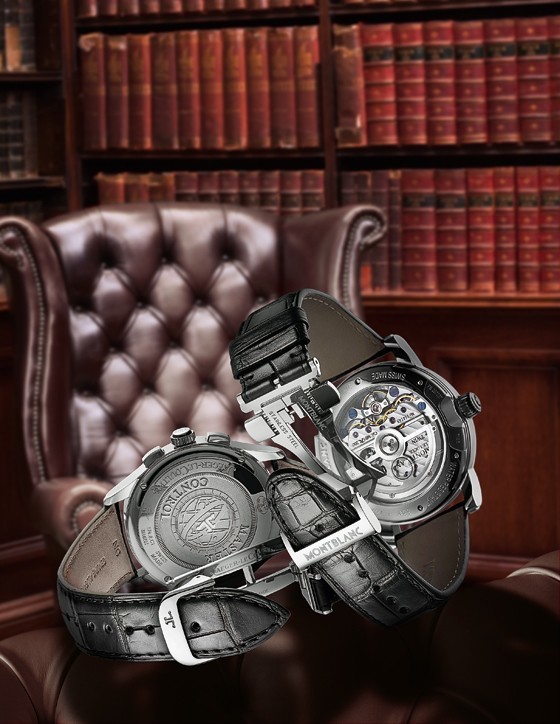
On the plus side, automatic Caliber MB R200 deserves credit for the very nearly perfect timekeeping performance of the Nicolas Rieussec Chronograph Automatic. Our electronic timing machine calculated daily gains of just 1.3 seconds in normal operation and 2.3 seconds with the chronograph switched on. Maximum differences among the positions were three seconds and one second, respectively. The small decline in the balance’s amplitude after the chronograph was coupled with the gear train proved that all moving parts are neatly crafted and that the chronograph mechanism uses only a small amount of energy. The decline averaged 13 percent of arc in the two flat positions and just eight degrees in the four hanging positions. This watch has no continually running seconds hand, so its rate on the wrist could be tested only while the chronograph was running: we measured a constant gain of three seconds per day.
Our timing machine also confirmed the excellent rate behavior of the Jaeger-LeCoultre watch. It posted small daily gains of 2.2 seconds in ordinary operation and 1.2 seconds with its chronograph running. Its balance’s amplitude declined only slightly when the stopwatch was switched on. We weren’t entirely satisfied with large average deviations of 16 and 15 seconds, respectively, among the individual positions. Daily deviation on the wrist ranged between -2.5 and +1 seconds.
Both chronograph calibers are constructed to offer numerous advantages. Each has a column wheel to assure the correct functioning of the chronograph’s commands and each relies on vertical coupling, which theoretically (and in this instance, practically, too) prevents the shudder that often mars the clean start of a chronograph’s elapsed-seconds hand. Both movements have freely swinging balances with weight screws along their rims. Each caliber contains two barrels, so the running autonomy of both watches is above average: 65 hours for Jaeger-LeCoultre and 72 hours for Montblanc.
Jaeger-LeCoultre’s caliber is thinner: just 5.7 mm, compared to Montblanc’s 8.5 mm. But Montblanc’s balace is borne beneath a bridge. And a bridge, which by definition has a support at each end, is inherently sturdier than a cantilevered balance cock like the one in the Jaeger watch.
Montblanc’s more elaborate embellishments put its caliber a nose ahead in the category of “movement quality.” The edges of plates and bridges aren’t merely beveled, they’re also polished, as are the throats of the ruby bearings and the holes for the screws. Montblanc blues its screws. And the various decorative patterns on Montblanc’s chronograph look more brilliant than those on Jaeger-LeCoultre’s caliber.
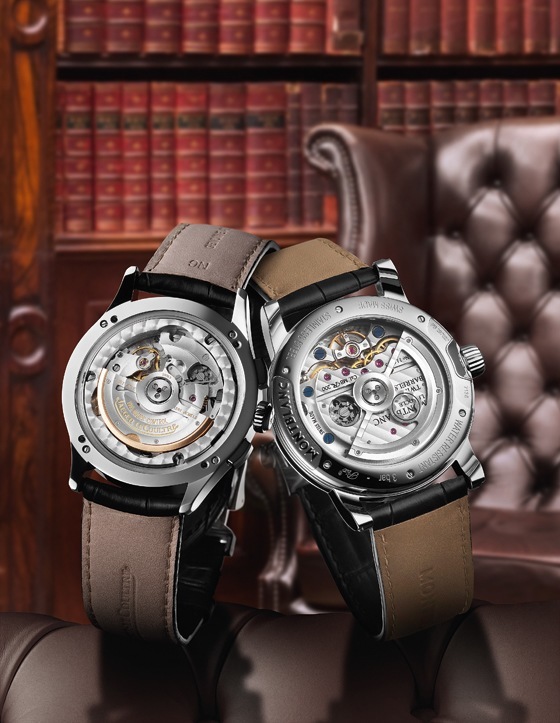
Jaeger-LeCoultre exercises restraint in its choice of embellishments, not only for the movement, but also for the rest of the watch. The opaque steel back is tastefully adorned with the “Master Control” logo in relief engraving. This emblem refers to the brand’s testing ordeal, the so-called “1,000-Hour Test.” After assembly, every watch bearing the Master Control name is subjected to a range of temperatures and to the rigors of water, shocks and vibrations for more than 41 days, during which time it must consistently demonstrate its proper functioning, its steady running behavior and the stability of its power reserve.
Which watch to buy? The choice between these two chronographs is like every decision about the purchase of a watch; it essentially depends on your favorite type.
SPECS/JAEGER-LECOULTRE MASTER CHRONOGRAPH:
Manufacturer: Manufacture Jaeger-LeCoultre, Rue de la Golisse 8, CH-1347 Le Sentier, Switzerland
Reference number: 1538420 Functions: Hours, minutes, small seconds; chronograph with counter for 12 elapsed hours and jumping counter for 30 elapsed minutes; date display; stop- seconds function
Movement: Self-winding manufacture Caliber 751A/1; 28,800 vph, 39 jewels, fine adjustment via weight screws on the Glucydur balance, Kif shock absorption, column wheel, vertical coupling, two barrels, 65-hour power reserve; diameter = 25.6 mm; height = 5.7 mm
Case: Stainless-steel case, domed sapphire crystal without nonreflective coating; stainless-steel back held by four screws; water resistant to 50 meters
Strap and clasp:Cut alligator strap with double-folding clasp made of stainless steel
Rate results:
(Deviations in seconds per 24 hours)
With chronograph switched off / on
Dial up: +12 / +10
Dial down: +8 / +6
Crown up: 0 / -1
Crown down: -4 / -5
Crown left: -3 / -2
Crown right: 0 / -1
Greatest deviation of rate: 16 / 15
Average deviation: +2.2 / +1.2
Dimensions: Diameter = 40 mm, height = 11.7 mm; weight = 94 grams
Average amplitude:
Flat positions 303° / 292°
Hanging positions 269° / 261°
Variations: With black dial; rose gold ($22,500*)
Price: $10,000*
SPECS/MONTBLANC NICOLAS RIEUSSEC CHRONOGRAPH AUTOMATIC
Manufacturer: Montblanc Montre S.A., Chemin des Tourelles 10, CH-2400 Le Locle, Switzerland
Reference number: 106488 Functions: Hours, minutes; monopusher chronograph with counters for 60 seconds and 30 elapsed minutes on rotating disks; second time zone with day-night display; date display; stop-seconds function
Movement: Self-winding manufacture Caliber MB R200, monopusher chronograph; 28,800 vph, 40 jewels, Incabloc shock absorption, fine adjustment via weight screws on the balance, column wheel, vertical coupling, balance bridge, two barrels, 72-hour power reserve; diameter = 31 mm, height = 8.5 mm
Case: Domed stainless-steel case, sapphire crystal is nonreflective on both sides, six screws hold caseback in place, caseback has a window of sapphire, water resistant to 30 meters
Strap and clasp: Cut alligator strap with safety folding clasp made of stainless steel
Rate results:
(Deviations in seconds per 24 hours)
With chronograph switched off / on
Dial up: 0 / +2
Dial down: +2 / +3
Crown up:+1 / +2
Crown down: +1 / +2
Crown left: +3 / +3
Crown right: +1 / +2
Greatest deviation of rate: B 3 / 1
Average deviation: +1.3 / +2.3
Average amplitude:
Flat positions 312° / 299°
Hanging positions 279° / 271°
Dimensions: Diameter = 43 mm, height = 14.8 mm; weight = 123 grams
Variations: With various dials; with stainless-steel bracelet ($11,000); anniversary editions in rose gold ($38,100) or in white gold ($40,900*)
Price: $10,700*
SCORES/MONTBLANC NICOLAS RIEUSSEC CHRONOGRAPH AUTOMATIC
Strap and clasp (10 points): The cut alligator strap and the milled folding clasp are well crafted. The clasp includes safety buttons. 8
Operation (5): The chronograph’s button and the clasp are easier to operate than the large, difficult-to-grasp crown; additive timing isn’t possible. 4
Case (10): The case is solidly crafted and designed with many appealing details, but it’s only moderately water resistant. 8
Design (15): The concept behind the styling is historic. The rounded case will appeal to some tastes, but not all. 13
Legibility (5): The small time display cannot be read with to-the-minute accuracy and the day-night indicator is confusing, but the chronograph disks and the date are easy to read. 3
Wearing comfort (10): The asymmetrical clasp presses uncomfortably against the underside of the wrist and the tall case is top heavy. 7
Movement (20): Very attractive construction and embellishments, but it could be thinner. 17
Rate results (10): Perfect rate results and scarcely any decline in amplitude when the chronograph is running. 10
Overall value (15): Well priced for a uniquely designed and elaborately crafted manufacture wristwatch. 13
TOTAL: 83 POINTS
SCORES/JAEGER-LECOULTRE MASTER CHRONOGRAPH
Strap and clasp (10 points): The cut alligator strap and the milled double-folding clasp are well crafted, but the clasp lacks buttons to open it. 8
Operation (5): The chronograph’s rectangular buttons are much easier to operate than the small crown and the clasp. The watch has a stop-seconds function and rapid adjustment for the date display, but the minutes hand jumps when the time is set. 3
Case (10): The case is simply styled but well crafted. Shaped push-pieces and a relief engraving on the back are handsome details. 8
Design (15): Consummate elegance, but no special features. 13
Legibility (5): The dial offers inadequate contrast despite the variously finished facets on the hands, and minutes numerals are lacking. The markings on the subdials are user-friendly and the date is readily legible. 3
Wearing comfort (10): The slim clasp fits almost as perfectly on the underside of the wrist as does the flat case on the back of the wrist. 9
Movement (20): Very good construction and appealing embellishments. 16
Rate results (10): Perfect average values, but deviations among the positions are too large. The amplitude barely declines when the chronograph is running. 6
Overall value (15): This watch reconfirms Jaeger-LeCoultre’s good cost-benefit ratio. 12
TOTAL: 78 POINTS
This article was originally published in the June 2013 issue of WatchTime. Original photos are by Nik Schölzel.
* Prices are subject to change.

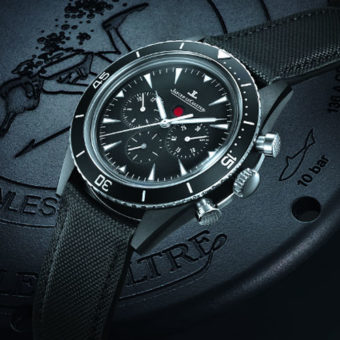
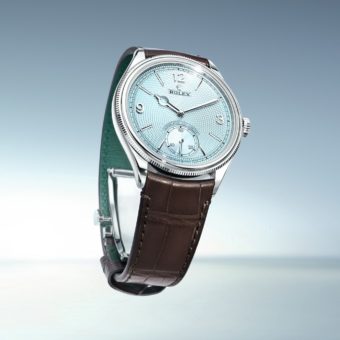
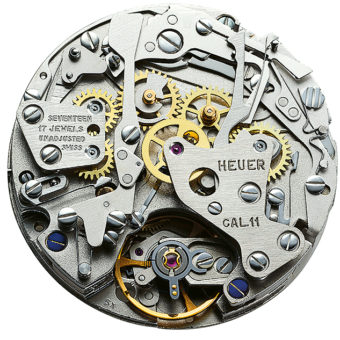
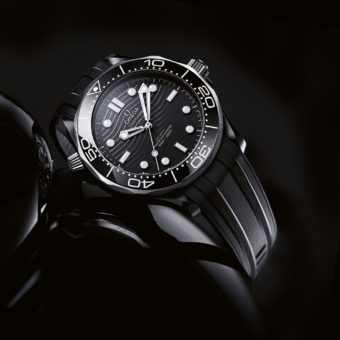
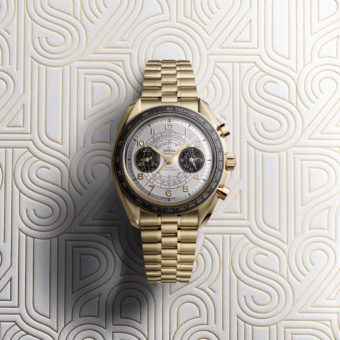
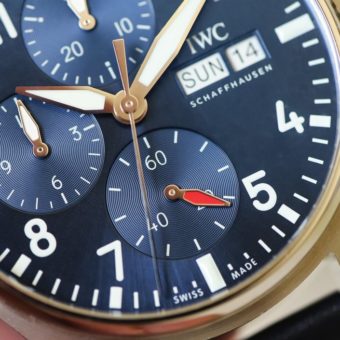
Ok. So first of all I’ll have to say that this
Article is written in a very deep detailed, knowledgeable, impressive and proffesional way.
You don’t miss any thing you got to know about comparing between both watches.
For the descition i will say; I haves dreamed of the montblanc Nicolas’s rieussec for 7 years.
When I turned 25 I bought the MB Nicolas Rieussec R200 model no. 106595.
And I can tell, proudly, I’m so lucky to buy this watch and wear it on my wrist.
I really beleave it worthies every single dollar I payed for it.
I put it on in every special occasion like holidays and events and meetings.
Always people are giving me very nice compliments about the special design of the watch; especially of the very-unique chronograph of this serie (“hey look-the discs are turning”!!!’).
So at the Boston line I can say, I’ve got my first dream of my life.
For the others I will say – if you really appreciate accuracy, 20’ century best micro technology, and top rated hand-crafting, don’t think twice- and make the right choice- Montblanc Nicolas Rieussec Automatic series watch will be on your wrist.
It is the beast of the best.
Another great article. No watch blog site tests watches for accuracy and does the rigorous comparison that Watch Time does. Every time i read a review on another site i see the difference immediately.
Hi Leon,
Thanks for the kind words which represent exactly the kind of journalistic integrity our team seeks to provide.
Cheers,
Im interested
I like both a lot but I would take the Jaeger all day everyday.
I really enjoy my Montblanc Rieussec and have gotten many positive comments about it.
I would have loved to see the jlc with a back sapphire window, however after reading the article I bought the jlc.
Such a well-written, comprehensive comparison… except one thing: how can the JLC have an opaque steel back. Except for Superman, we can’t see through steel. Therefore, it would have been good to point out that you can not see the JLC chrono movement and can see the Montblanc’s, although it’s quite confusing with the photo showing both movements. It appears that as is done with showing Rolex movements, the photo was taken after the caseback was removed.
I think that the JLC case deserves more points than the Montblanc. NOt only is it more water resistant and secure, but it is also considerably thinner and smaller in diameter. 40 mm is plenty big, but 43 mm is a bit oversized for many.